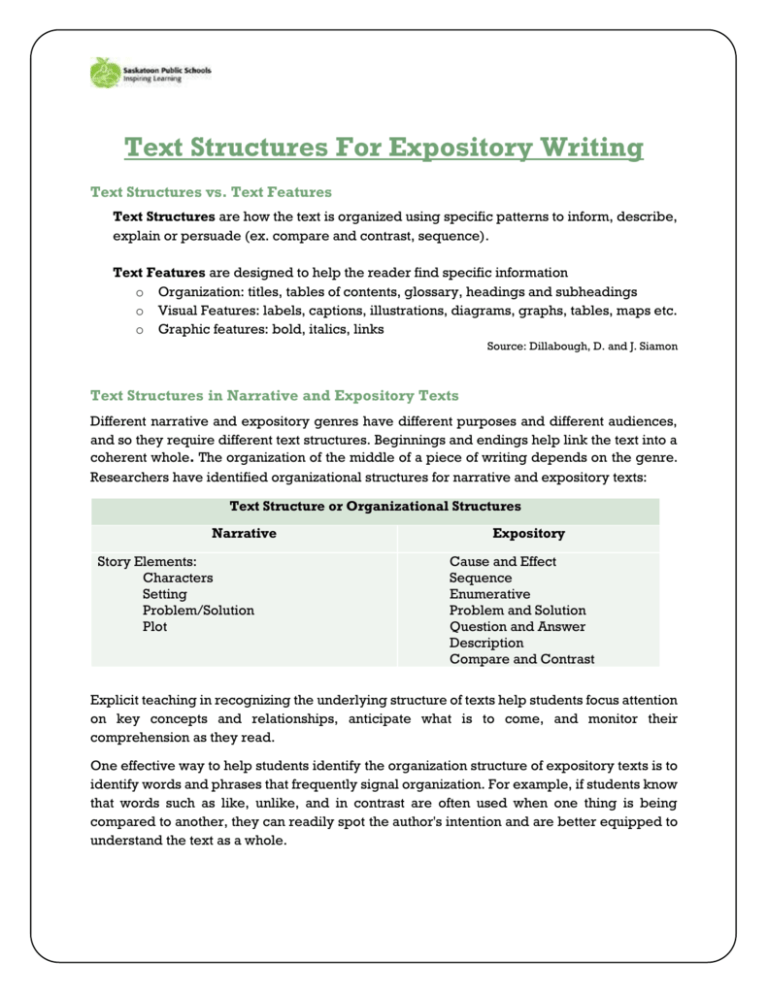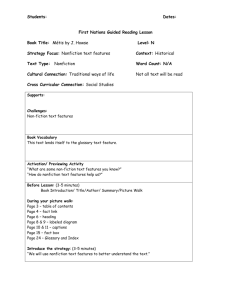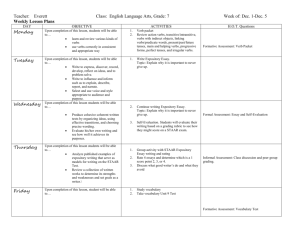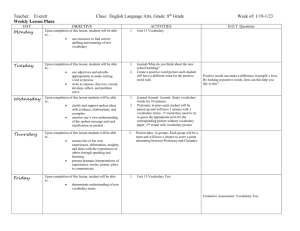Text Structures For Expository Writing
advertisement

Text Structures For Expository Writing Text Structures vs. Text Features Text Structures are how the text is organized using specific patterns to inform, describe, explain or persuade (ex. compare and contrast, sequence). Text Features are designed to help the reader find specific information o Organization: titles, tables of contents, glossary, headings and subheadings o Visual Features: labels, captions, illustrations, diagrams, graphs, tables, maps etc. o Graphic features: bold, italics, links Source: Dillabough, D. and J. Siamon Text Structures in Narrative and Expository Texts Different narrative and expository genres have different purposes and different audiences, and so they require different text structures. Beginnings and endings help link the text into a coherent whole. The organization of the middle of a piece of writing depends on the genre. Researchers have identified organizational structures for narrative and expository texts: Text Structure or Organizational Structures Narrative Story Elements: Characters Setting Problem/Solution Plot Expository Cause and Effect Sequence Enumerative Problem and Solution Question and Answer Description Compare and Contrast Explicit teaching in recognizing the underlying structure of texts help students focus attention on key concepts and relationships, anticipate what is to come, and monitor their comprehension as they read. One effective way to help students identify the organization structure of expository texts is to identify words and phrases that frequently signal organization. For example, if students know that words such as like, unlike, and in contrast are often used when one thing is being compared to another, they can readily spot the author's intention and are better equipped to understand the text as a whole. Structure Definition Signal Words Sequential A series of events presented in the order they happened (chronological). High order thinking does not occur – writer is talking about. first, second, third, next, meanwhile, on [date], not long after, today, tomorrow, once, soon, final(ly), at last, now, before, after, while, then, later Enumerative A main idea followed by examples that are not in a defined order. High order thinking does not occur – writer is talking about. first, second, third, then, also, for instance, for example, to begin with, furthermore, in addition, more importantly, more, next, finally, in fact, at last, another, other Compare and Contrast The similarities and differences between two or more subjects. Higher order thinking occurs because the writer must use criteria to determine similarities and differences. compare, contrast, also, too, between, difference, on one hand, on the other hand, unlike, even though, more, than, like, similar, while, resembles, in common, both, rather, opposed to Cause and Effect Cause plus possible effects, or an effect with possible causes. (Jan is sick. This may be a result of all the candy she ate or it could be a consequence of not washing her hands). Higher level thinking occurs when the writer tries to establish one cause by eliminating others, or attempts to prove the cause resulted in the effect. as a result, because, due to, this led to, nevertheless, if, then, in order that, unless, since, so that, thus, therefore, accordingly, so, consequently, another reason, for this reason, on account of, some consequences are Problem and solution An issue is presented and a one or more potential ways to fix it are explained. Higher level thinking occurs when one is selected and justified with reasons. a problem is, a solution is, the problem is solved by, purpose, conclude, in conclusion, research shows, the evidence is, one reason is, issues are, propose, conclude, resolved by, issues are Question and answer A question is followed by one or more answers to the question. Higher level thinking occurs when the question is high level (not Google-able, about). how, why, when, who, what, how many, where, as a result of, question, answer Description A topic is discussed and the characteristic or attributes are described. Sensory and descriptive language Saskatoon Public Schools Text Structure Signal Questions and Signal Words 2 Saskatoon Public Schools Text Structure Signal Questions and Signal Words 3 Sequential A series of events or steps in a process is being described. What items, events, or steps are listed? What is the process? Can the steps or process be changed? First, second, third Next On [date] Today, Tomorrow Finally Now, then, soon Enumerative A main idea followed by examples that are not in a defined order. What examples support the main idea? What proof is there? For instance For example To begin with More importantly, Another Other Compare and Contrast Shows how two or more things are alike and how they are different. What things are being compared? In what ways are they alike? In what ways are they different? Same as Similar Alike Different from As opposed to Both Instead of Cause and Effect Explains why something happened (cause) and what happened (effect). What happened? Why did it happen? What caused it to happen? Therefore Because If…then This led to As a result Reason why Problem and Solution Tells about a problem and then gives one or more possible solutions. What is the problem? Why is there a problem? What can be done to solve the problem? Question is… The puzzle is… To solve this… One reason for the problem is… Question and Answer A question is followed by one or more possible answers. What is the question? What are the possible answers? How Why What How many Where As a result of Description A topic is described by listing its characteristics or attributes. What specific thing or topic is being described? What is important to remember about it? For instance Such as… To begin with An example To illustrate Characteristics Saskatoon Public Schools Instructional Strategies 4 Instructional Reminders Clarity (Be Clear What You Mean) Teach text structures/organization explicitly Use common language for terms Do Not Use A Variety of Terms: Lead, Introduction, Topic Body, Development, Expansion, Example Transition, Sequence, Signal Conclusion, Ending, Resolution, Tie-Back Show students organizational structures (what it looks like) using anonymous samples, content area, and textbook (mentor texts) samples Have students find characteristics in samples (inductive processes for the more advanced) Check understanding by having students self-ask, “How does knowing or being familiar with text structures or how a text is organized help me as a reader?” Scaffold initial writing, such as the use of writing frames for primary students Post criteria (anchor charts) and make explicit and repeated references Have students self-assess and set feed forward goals Tool Selection (Use the Right Tool for the Mental Task) Use technical tools for organization o Inspiration tips o Smart Art in Microsoft Word Imagine the right graphic organizer for the type and structure of writing Use a variety of engaging instructional strategies o Refer to attached instructional ideas Saskatoon Public Schools Assess (Where Are You? And Where Do You Want To Go Next?) 5 Assess often, evaluate rarely Release control o Gradual release of responsibility cycle Track by type of expository text organization Instructional Ideas 1. Show students how writers use text structures to organize information. Introduce the concept to them, and reinforce it every time students read and write. Text Structure Examples allow students to see how each structure looks using the same topic. (http://www.literacyleader.com/sites/litlead.essdack.org/files/Text%20Structure%20Goose%20Bumps %20examples.doc) 2. Skim and scan to predict text structure(s). Make predicting possible text structures a part of every pre-reading activity. 3. Teach the signal words for each text structure. Provide explicit instruction in showing students specifically how to attend to signal words while reading different content areas or using signal words when writing expository text. Prior to reading, skim and scan passages and make predictions about text structure. During reading, analyze text and revise predictions about structure. 4. Teach and model the use of graphic organizers to go with each text structure. Identify text structures in advance and provide appropriate advanced organizer. For example, modelling charting the structure of specific paragraphs while reading and also provides practice in using the graphic organizer to write different text types. This site has printable Graphic Organizers for five of the text structures. (http://www.literacyleader.com/sites/litlead.essdack.org/files/Text%20features.structures.pdf) Text Structure Workmat allows students to put a paragraph or article in the middle of the mat and have a visual of all graphic organizers that might help them identify the structure of the text. 5. Scaffold instruction using the gradual release of responsibility model. Spend quality instructional time in each phase of the model when teaching text structure strategies. For example, use a think aloud to model for demonstration. Then invite students to participate for shared demonstration. Students then practice with teacher support for guided practice. Finally, students apply the skills and strategies they have learned for independent practice. 6. Model a think-aloud strategy. Read aloud a paragraph, pausing at appropriate points to share own comprehension strategies and understanding of the text. Next move to a shared-reading strategy, encouraging students to talk aloud as they engage in the process with the teacher. For example, ask students to talk about the clues they use to try to identify the text structure. Saskatoon Public Schools (http://www.literacyleader.com/sites/litlead.essdack.org/files/Text%20Structure%20Workmat.pdf) 6 Sample Think Abouts from Traits of Writing (Culham) Creating the lead Did I give the reader something interesting to think about from the start? Will the reader want to keep reading? Have I tried to keep the reader’s attention Did I let the reader know what is coming Structuring the body Have I shown the reader where to slow down and speed up? Do all the details fit where they are placed? Will the reader find it easy to follow my ideas? Does my organization help the main idea stand out? Ending with a sense of resolution Have I wrapped up all the loose ends? Have I ended in the best place? Do I have an ending that meets the reader’s needs? Did I leave the reader with something to think about? 7. Ask focusing questions targeting text structure. Use focusing questions as a means of scaffolding the use of strategies or assisting students in the think-aloud process. For example, ask a student which signal word might be best to show a particular relationship among ideas in a text structure. 8. Create and provide pattern guides and teacher-made organizers that reflect that structure of the original text. These tools help students focus on the key elements of the reading selection. Model the use of technical tools for organization such as Inspiration, Kidspriration, or Smart Art in Microsoft Word. 9. Present students with a completed graphic organizer as a pre-reading strategy. Have students write a probable paragraph using a predicted text structure prior to reading. After reading, compare students’ probable passages and the original text. Saskatoon Public Schools 10. Write using the text structures. While students watch, model writing a paragraph using a particular text structure and describes actions while writing. Then students write their own paragraphs using text structure/ paragraph frames as templates. Frame (Fill in the blank paragraph) Topic Sentence or Introduction During the week before Christmas, our class had lots of fun. The first thing we did was _________________________________________. The second activity was ______________________. After that, we _____________________________________ _______________________. Finally, we _________________________________________. We had a great time! Concluding sentence or clincher 7 Signal words 11. Make the connection between reading and writing. Teach organization or structure of text using mentor texts. When students read an example of a particular text structure, have them write using that same text structure. Writing can be done as a pre-reading or post-reading strategy. 12. Rewrite a paragraph or passage using a different text structure than the original. Compare the two and analyze why the author might have chosen the original pattern. 13. Read and analyze a variety of text, both single-structure passages and multistructure passages. Use every opportunity that students read as an opportunity to teach text structure. 14. Have a text structure treasure hunt with a newspaper, classroom magazine, nonfiction book, textbook chapter, or students’ independent reading material 15. Use summary frame questions to guide students’ comprehension before, during, and after reading. Each organizational structure suggests questions which readers should consider as they are reading and be able to answer once they've finished reading the passage. 16. Use text coding strategies – highlighters, Post-It Notes, etc. – targeting text structures. Remember to model these strategies in advance and be consistent in your procedures (same colour each time, etc.). For additional coding ideas, visit the Text Mapping site: http://www.textmapping.org/overview.html 17. Use text structure sorts to compare different paragraphs on a single topic. Begin by analyzing and sorting only one text structure at a time, then add another and so on. Text Structure Paragraphs that can be used as examples or a sorting activity: elementary samples and secondary samples. (http://www.literacyleader.com/sites/litlead.essdack.org/files/Text%20structure%20sorts%20%20elm. pdf) (http://www.literacyleader.com/sites/litlead.essdack.org/files/text%20structure%20sort%20secondary _0.pdf) Source: http://www.literacyleader.com/sites/litlead.essdack.org/files/TextStructureResources.pdf Saskatoon Public Schools 18. Organize texts. Write each sentence or phrase of an expository text on a sentence strip. Students organize the text. Use timed trials to add motivate students. 8 Saskatoon Public Schools Resources 9 Websites on Identifying Text Structure Literacy Matters: Text Structure http://www.literacymatters.org/content/text/intro.htm#geninfo Text Structure Resources http://www.literacyleader.com/?q=textstructure Text Structure http://forpd.ucf.edu/strategies/strattextstructure.html Structural Clues in Nonfiction - PDF http://www.eastsideliteracy.org/tutorsupport/documents/HO_StructuralClues.pdf Text Structure Resources from eThemes - Includes links to lessons and ideas for teaching at grades 2-6 (http://www.emints.org/ethemes/resources/S00001273.shtml). ReadWriteThink – Juried lesson plans. Search by text structure and grade level for multiple ideas (http://readwritethink.org/). Online Resources for Teaching Text Structure Teaching Text Structure & More PPT http://www.literacyleader.com/sites/litlead.essdack.org/files/Text%20Structure%20G CHS.ppt.pdf Printable graphic organizers for various text types http://t4.jordan.k12.ut.us/teacher_resources/inspiration_templates/#cause Instructional techniques for text structure with links http://www.literacymatters.org/content/text/intro.htm Printable STUDENT page from Scholastic http://teacher.scholastic.com/reading/bestpractices/nonfiction/fiveTextStructures.pdf Information from Heinemann http://www.heinemannlibrary.com/tools/Nonfiction_Instruction.pdf Print Resources Atwell, Nancie. Lessons that change writers. Portsmouth, NH: Firsthand/Heinemann, 2002. Calkins, Lucy. Units of study for primary writing: a yearlong curriculum. Portsmouth, NH: FirstHand, 2003. Portsmouth, NH: FirstHand, 2006. Culham, Ruth. 6 + 1 traits of writing: the complete guide, grades 3 and up. New York: Scholastic Professional Books, 2003. Culham, Ruth. 6 + 1 traits of writing. New York: Scholastic, 2005. Culham, Ruth, and Raymond Coutu. Using picture books to teach writing with the traits an annotated bibliography of more than 150 mentor texts with teacher-tested lessons. New Saskatoon Public Schools Calkins, Lucy, and Leah Mermelstein. A guide to the writing workshop, grades 3-5. 10 York: Scholastic, 2008. Culham, Ruth. Traits of writing: the complete guide for middle school. New York: Scholastic, 2010. Gear, Adrienne. Reading power: teaching students to think while they read. Markham, Ont.: Pembroke Publishers, 2006. Gear, Adrienne. Nonfiction reading power teaching students how to think while they read all kinds of information. Markham, Ont.: Pembroke Publishers, 2008. Gear, Adrienne. Writing power teaching writing strategies that engage thinking. Markham, Ont.: Pembroke Publishers, 2011. Goudvis, Anne, and Stephanie Harvey. Strategies That Work: Teaching Comprehension for Understanding and Engagement. Toronto: Stenhouse Pub, 2007. Harvey, Stephanie and Goudvis, Anne. Toolkit Texts Short Nonfiction for Guided and Independent Practice. Heinemann, 2007. Grades 2-3. CD included. Harvey, Stephanie and Goudvis, Anne. Toolkit Texts Short Nonfiction for Guided and Independent Practice. Heinemann, 2007. Grades 4-5. CD included. Harvey, Stephanie and Goudvis, Anne. Toolkit Texts Short Nonfiction for Guided and Independent Practice. Heinemann, 2007. Grades 6-7. CD included. Keene, Ellin Oliver, and Susan Zimmermann. Mosaic of Thought, Second Edition: The Power of Comprehension Strategy Instruction. Chicago: Heinemann, 2007. Keene, Ellin Oliver. To Understand: New Horizons in Reading Comprehension. Chicago: Heinemann, 2008. Miller, Debbie. Reading With Meaning: Teaching Comprehension in the Primary Grades. Portland, Maine: Stenhouse, 2002. Saskatoon Public Schools Peery, Angela B.. Writing matters in every classroom. Englewood, Colo.: Lead + Learn Press/Leadership and Learning Center, 2009. 11








